Behind the Scenes with Ingrid from Forsythia Productions
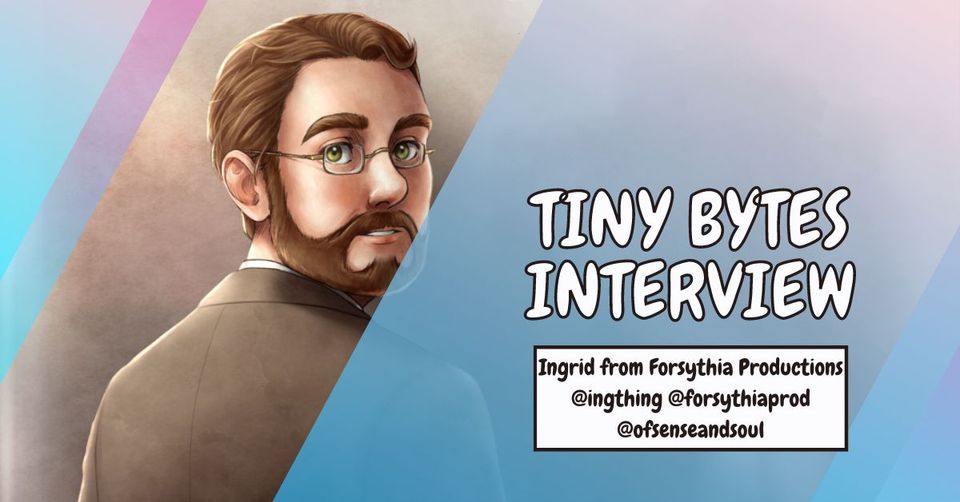
Ingrid, also known as Ing or ingthing online, is an artist, designer, and visual novel developer. While she has helped many projects by creating backgrounds, GUIs, and logos for them, she is also one half of Forsythia Productions, the other member being Akaparalian. Forsythia Productions is currently working on Of Sense and Soul, a queer Victorian romance that focuses on two men: Hugo and Seamus. Today, we sat down with Ingrid to learn more about her, her journey in game development, her advice on creating assets like GUIs and backgrounds, and much more!
Hi! Can you tell us a bit about yourself and how you got into game development?
Of course! I'm Ingrid (ingthing) and I'm an artist, designer, and lead developer over at Forsythia Productions, my dev studio. I stumbled into game development because my childhood love for visual novels revived a few years ago with the plan of telling a particular story—that story being my game, Of Sense and Soul.
You’ve worked on a few games to create assets (i.e., GUI and logos) and background work. These games include Vivica’s Heart, Parasite in Love, and TEISATSU. Let’s focus on backgrounds first. When it comes to making a background, where do you start?
Funnily enough, I never would have considered myself a background artist a year ago! But I suppose I have drawn quite a few by now…
I usually draw interiors, so what I like to think of first is whether the setting is public or private—is it a setting that appears only during intimate or isolated scenes, or is it one that is more lively and impersonal? And if there's a designated purpose of the room, such as being a living room or a bedroom, how is it used, and what objects should be in the space?
Once I have a good sense of that, I search for references, maybe create a 3D model (I use Homestyler) and then get the foundations down.
I actually tend to paint in grayscale for backgrounds rather than line and colour them like the rest of my work—I find this makes me less fussy about mistakes and more concerned about the whole image.
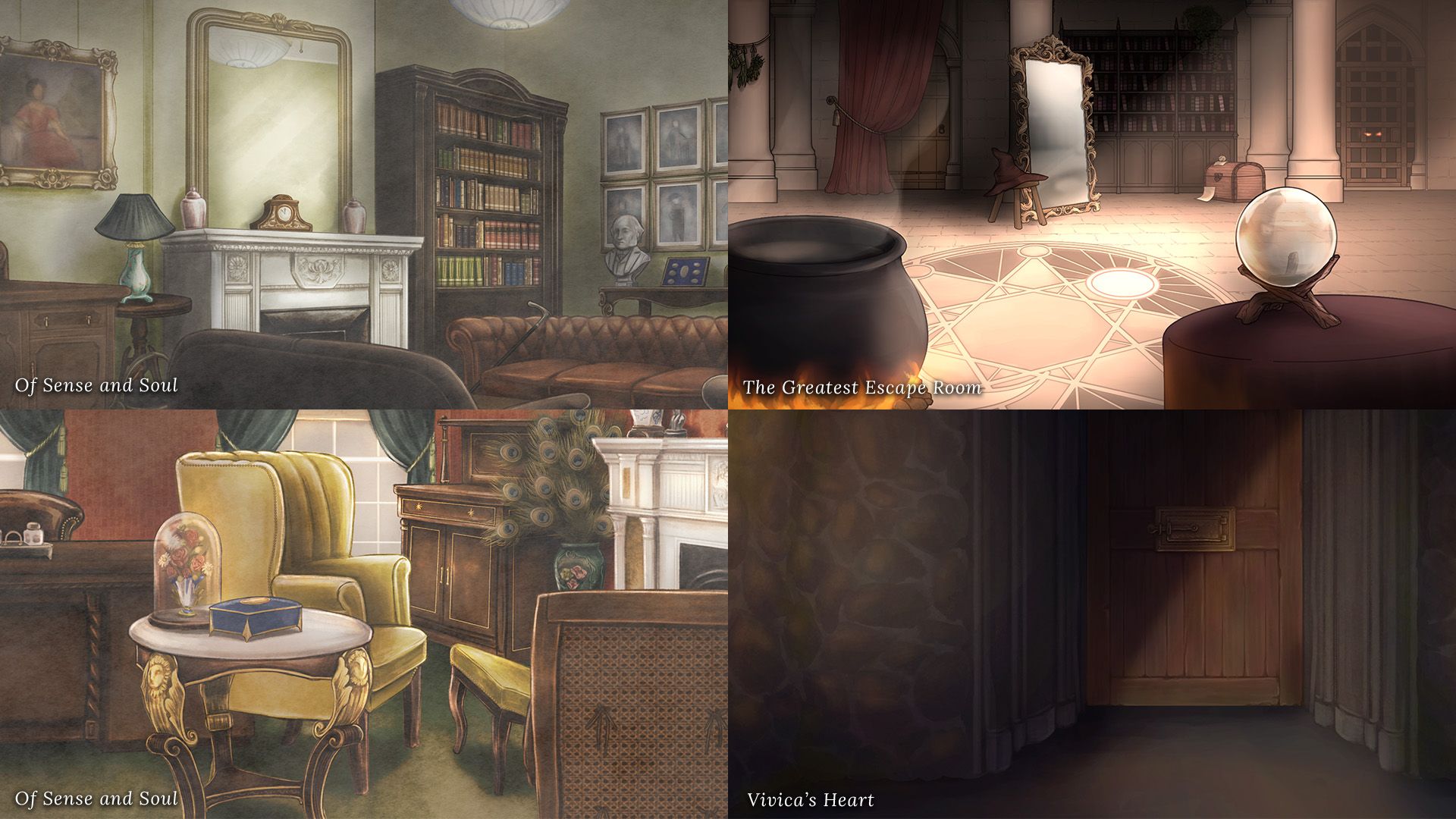
To you, what makes for a good background, and do you have any advice for artists who want to improve on creating backgrounds?
A good background to me isn't one that looks "perfect" or "real"—it's one that suits the game and story it will exist in. I think the most important thing to do is make a space feel lived-in. Think about the storytelling of a space—what details are important to telling that story, and what aren't?
In the below image from a background demo I did last year, I talk about the character and personality of a room—how the clutter and the way the space is navigated/used can help you add details that will draw the viewer's eye, away from empty corners or simpler elements.
Of course, as with any type of art, use references, references, references! Observing not just photos but also the world around you is the best way to start improving on background art. It hones your spatial senses and builds your "reservoir" of references you can whip out from your brain any time!
And when in doubt—break up any bare corners or edges by covering them. If everything in the room looks very crisp and neat, it is easier to notice bareness and mistakes. Adding clutter, as messy as it seems, can make it not only easier to pull attention away from those spots, but also make it more interesting for you to work on the background.
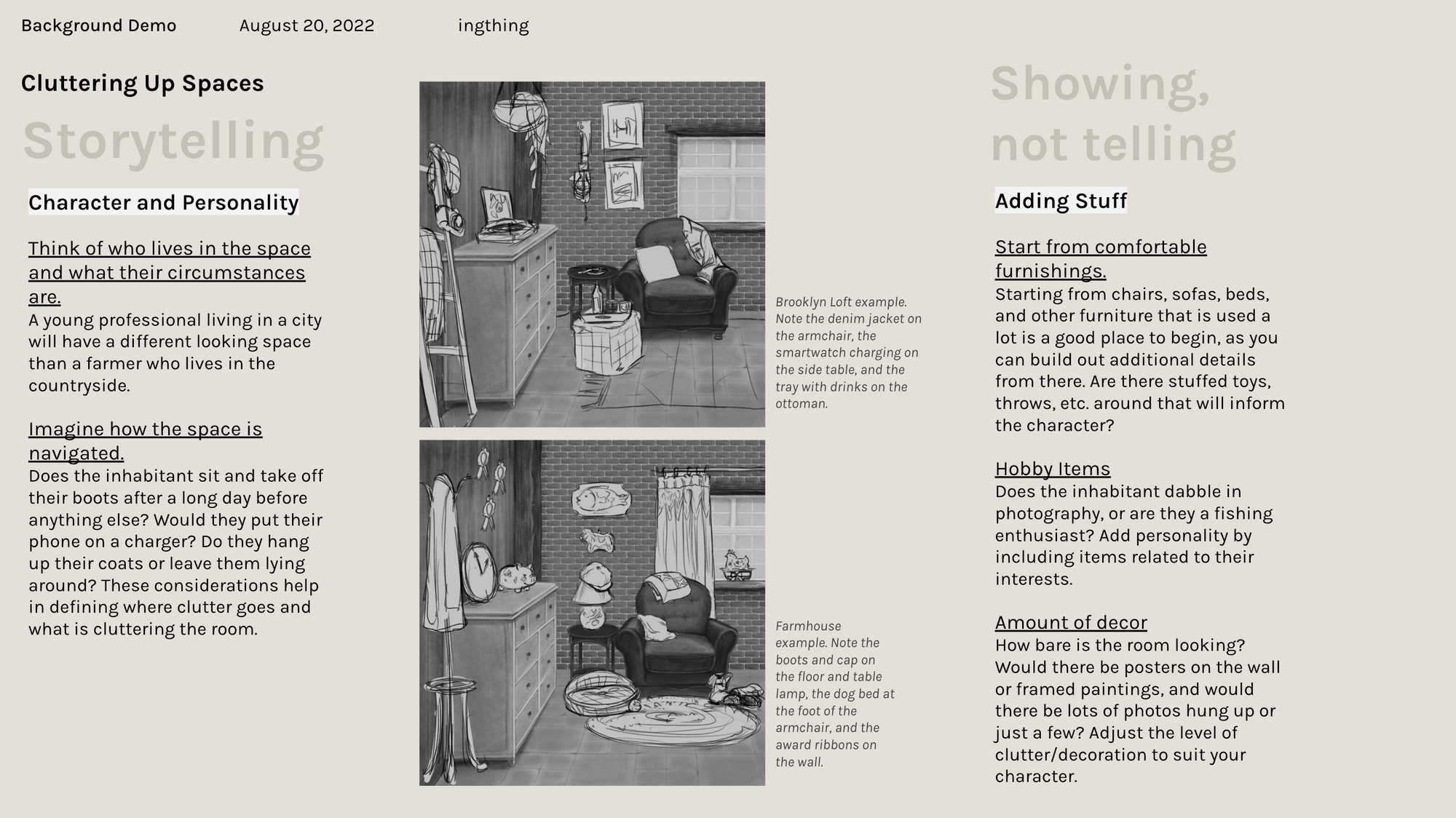
Let’s talk about GUI. GUI is one of the assets that developers struggle with the most. What is your creative process for creating a GUI? What are some things you consider when making a GUI?
It is very tricky to even start thinking about GUI because there can be a clash between the functional aspects versus the creative aspects, especially in visual novels where GUIs tend to be very themed.
My creative process first starts with understanding the story and the mechanics that will be included in it. A game like Parasite in Love, for example, has a very different tone and aim than a game like Once Upon an Earl. Then, I begin to research and brainstorm ideas for color palettes, textures, decorations, and shapes, based on that theme.
Thankfully, VNs mostly share a common set of interface elements, so I can use those menus and buttons as a base for whatever I design. But I also like to get creative with them!
In Parasite in Love, for example, the UI changes and "corrupts" as the story progresses. In Once Upon an Earl, the game menus transition by panning across a long hallway of silhouetted ballroom dancers, and the buttons for the CG gallery are "windows" along the hallway.
This, of course, is also up to the ability of the programmers involved—but I've found most are very enthusiastic to take GUI to the next level!
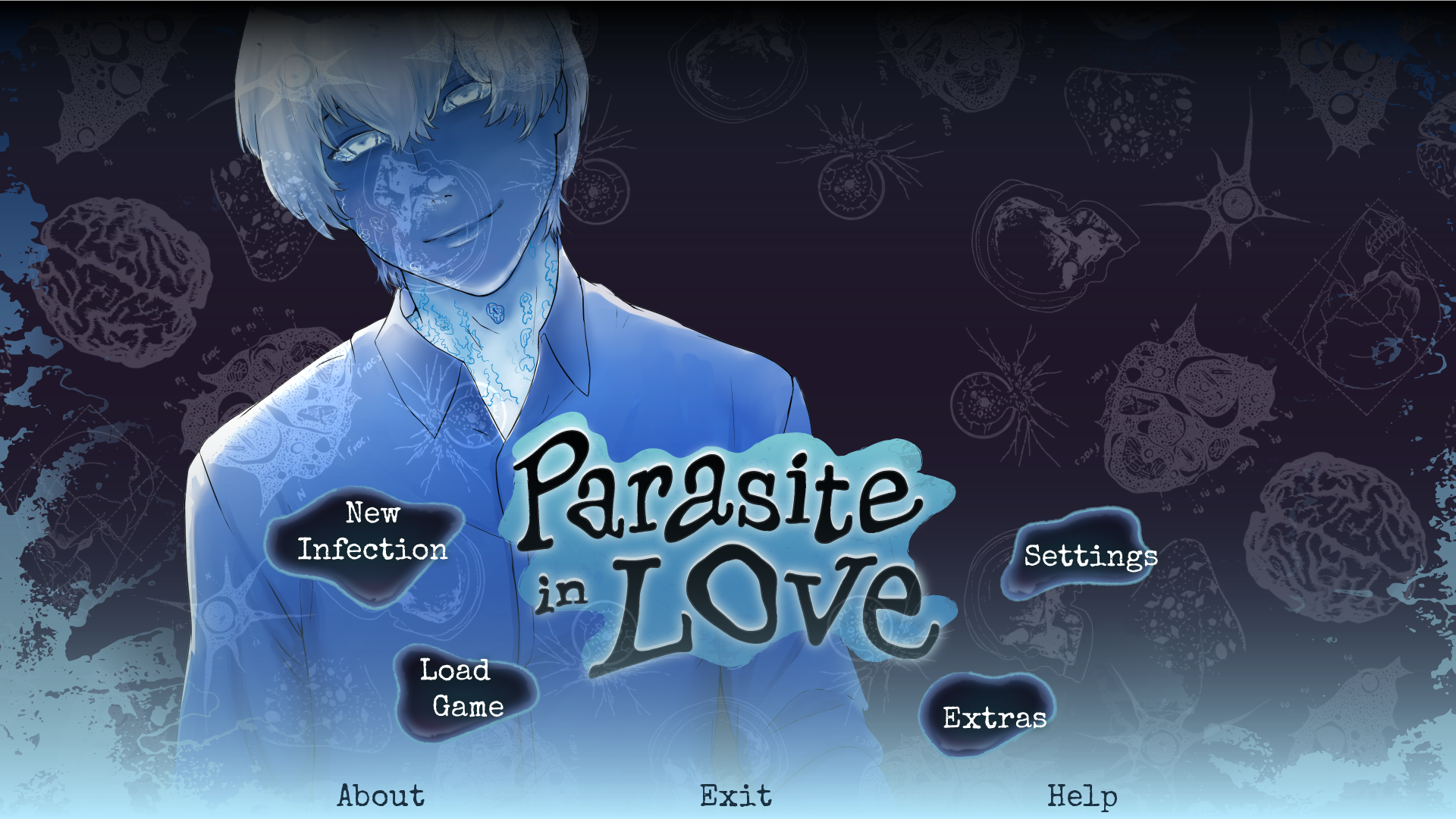
Re-using the same question from earlier, in your opinion, what makes for a good GUI? Any advice for artists who aren’t sure where to start when it comes to GUI creation?
A good UI to me is one that doesn't obstruct the player experience and enhances the storytelling. It has to be accessible in terms of reading experience, and it has to visually match the tone of the story.
(Storytelling is a Big Thing in my creative process, can you tell?)
For anyone who isn't sure where to start on GUI creation, I would recommend some of the same advice I gave above: search for references from other games you love and observe their GUI elements to figure out how they carry the theme across the game. Having a colour palette, pattern, ornament, or other unifying motif will help bring a UI together.
It can be difficult as a beginner to UI to make one from scratch without guidance—I would recommend downloading a free UI pack for whatever engine you're using and using the dimensions of the images there to guide your own asset creation and checklist.
I would also recommend inserting assets into your game as you go, instead of creating them all at once before implementing them. This way, you can adjust assets as they begin to fit together on screen and you can assess how things are looking.
(As a general note on how to plan any visuals for your game, may I suggest watching my VN;Conf 2023 talk on art direction? It may prove useful!)
While we are on the topic of premade assets, we have seen an unfortunate rise in AI art on sites like itch when it comes to backgrounds and sprites. What are your thoughts about that?
I can see why some might resort to using AI generated work for assets for either commercial sale or for their own games—there is no real labor involved, and there is a novelty to the wealth of "options" you can generate. However, as someone who takes pride in and values the manual creation of art and assets, I'm of the opinion that AI generated work takes value and opportunities away from creative people and damages the view of creative work overall—the same way mass manufacturing has taken away from artisans and craftsmen.
I think the use of AI art to make stock assets for games in specific can put indie game devs in a position of devaluing the work required to manually create those assets in a space where many freelancers are already underpaid and overworked. We should be cultivating and boosting the perceived value of art, not undercutting it. Developing a game is just as creative a pursuit as making art is—it makes no sense to me to pit one against the other when they're stronger together.
Beyond the moral implications lies a more inescapable issue with AI art for game assets: consistency. A game's art style is dependent on having assets that go together well, not only in colors or style but also in proportion and scale. An AI art generator may do well with standalone art pieces given certain criteria, but for the technical challenges of a game's appearance, which uses many different artworks, it may not be up to task for generating sprites or backgrounds to a story or game's specific needs.
Ultimately, you will have more agency and control over your art with manually made assets—even premade ones.
For game developers who want to avoid using AI art in their games, what is your advice to them on what they should look out for if they wanted to know if a piece of art was AI generated?
I'm not in the habit of examining AI work often, but there are often telltale signs of generation in the trueness of details to life.
The most notable/memed-about example may be AIs generating hands with six or more fingers. While there are people who have more (or less) than five fingers on each hand, that's not the average number most humans have, nor is it what we usually expect when we see hands.
You can also look out for areas with poor delineation between different parts of an image. If a bus' headlight blends into the background next to it or the hair falling down a person's shoulder seems to merge with their collar or neck, that's likely not a human error.
Lastly, look out for clothing details such as shirt collars, skirts, and accessories. AI is great at putting down the right colors and approximating the right shapes, but you'll often find it suffers in the realism department. A collar might look way different from a typical shirt collar, a skirt's fabric might fall unnaturally, and accessories may not be shaped correctly (like if the beads on a necklace don't seem to follow rhyme or reason).
Let’s talk about Of Sense and Soul, your queer Victorian visual novel set in 1875 London. You’re a big fan of history, as you have your own historical server. Can you tell us a bit about where that love for history came from?
Something about the lives of humans in the past has always been of interest to me, and I read a lot of kid-oriented history books as a child. It was only with Of Sense and Soul that I became much more engrossed by it, because beyond just looking at history as a retrospective, I have had to consider the daily lives and unique perspectives of people who lived in the past.
I can attribute my love for the Victorian Era specifically to two sources: the manga series Emma by Kaoru Mori (an absolutely gorgeous romance set in the late 1890s between a maid-of-all-work and a gentleman) and a university course I took about the history of design, in which I learned about design movements such as the Arts & Crafts Movement, as well as other aspects of the decorative arts that speak so much to the lives and perceptions of the Victorians in their rapidly changing society!
My favourite part about history is that at the heart of it, people always have been people, and I think they might be more relatable than we'd think! There's always something new (ironically) to learn from the past.
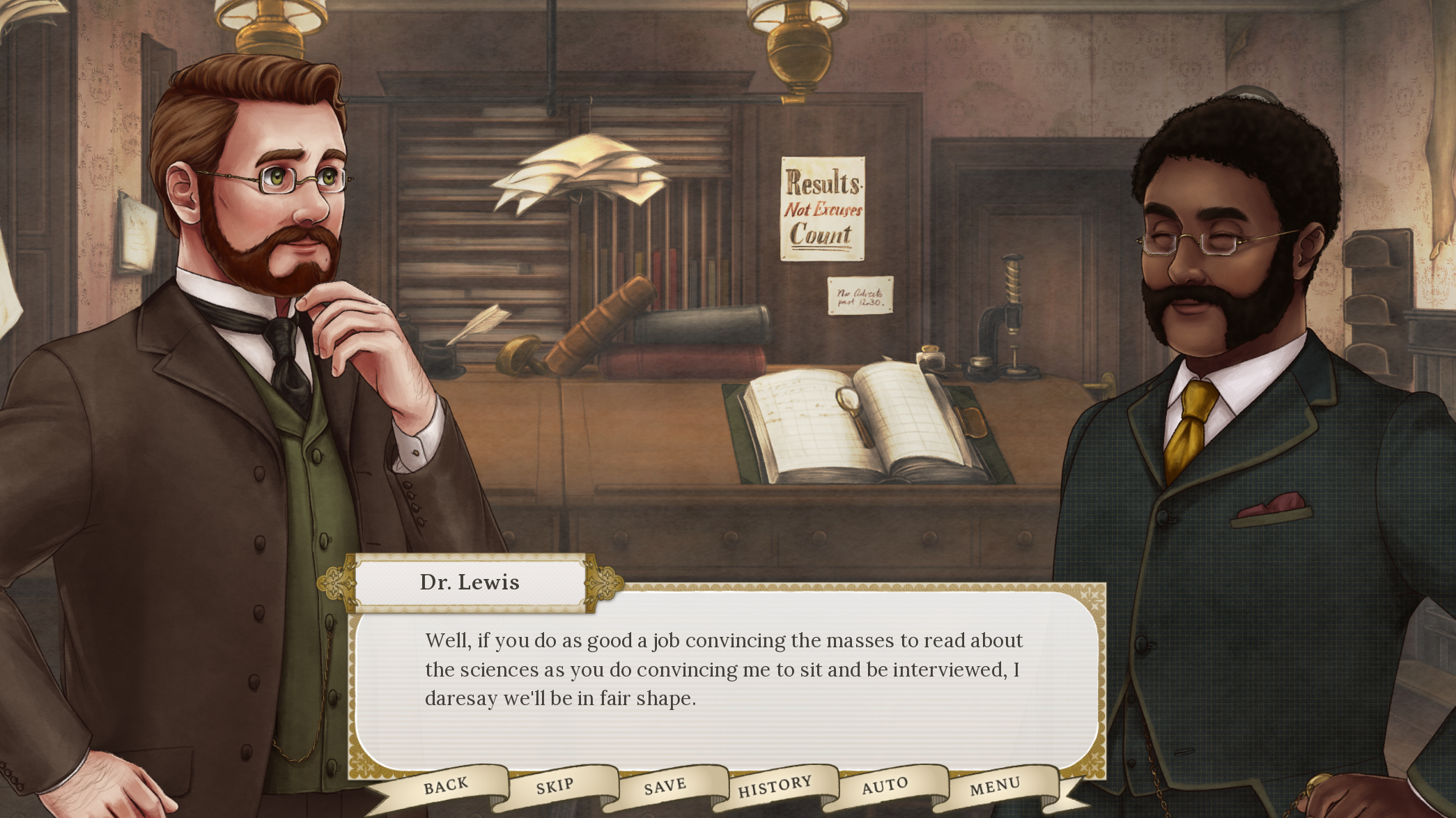
How did the idea of Of Sense and Soul come about, and what made you decide to set the game in 1875 London?
Of Sense and Soul was actually first born as a webcomic idea way back in 2016! My co-writer AKA and I decided it'd be cool to make a gay historical romance, and the Victorian era was something I had an interest in already.
The original idea was really just that—"let's make something gay and historical!"—and as such the first outline we drafted for the story was completely different beyond how Hugo and Seamus first meet. The plot used to be more centered on their romance and actually didn't contain a lot about the characters' individual paths. This changed with the shift from webcomic to visual novel, when the idea of making both characters playable came about. Then, we really dove into the bigger picture of what the game would convey and how the plot would culminate in it.
As for the specificity of the year, I honestly don't remember much about why we chose specifically 1875. I suspect it has to do with my preference for Victorian bustle era fashion (which began in the 1870s) as well as the modern preoccupation on anti-LGBT events in the 1880s onward (like Oscar Wilde's trials). We just didn't want to have that as a shadow over the narrative, or to make that the focus.
The 1870s are also a decade that are a little less documented/portrayed than, say, the 1880s or 1890s, which gives us some more room to play with the setting!
Moving onto Of Sense and Soul’s story, it focuses on two British men, Hugo Brooks and Seamus Charkham, men who both need change in their life. The two meet each other after Hugo reads Seamus’ ad in the paper mistaking him for a woman. Can you talk to us a bit about the themes for the game and how they’re connected to the protagonists?
The game's guiding force is the link between personal growth and deepened connection: we like to think that it's when both culminate together that the best outcomes can be achieved. And so, the first meeting between Seamus and Hugo not only sparks their romance, but also is the catalyst for personal growth.
Their stories are a bit different: Hugo's story is about him opening up to the world and becoming more assertive about the things and people he cares about. Seamus' story is about him coming to terms with the past, owning up to his mistakes, and seeking a way forward. Despite them each not being in the best of places at the start, their differences give each other a lot to feed off of and grow through.
Seamus, being a more sociable, put-together person, is someone Hugo grows to admire for his perceived confidence and poise—so Hugo begins to develop his own self-image and assertion as a result.
Hugo, being a more poetic, earnest person, is someone Seamus appreciates for his frankness and sense of wonder. This pulls Seamus towards being more honest with himself as well as others, which helps him work through bottled-up issues. Their connection, in addition to the many influences of the people and circumstances around them, provides a springboard for individual change…if the player decides to make the jump!
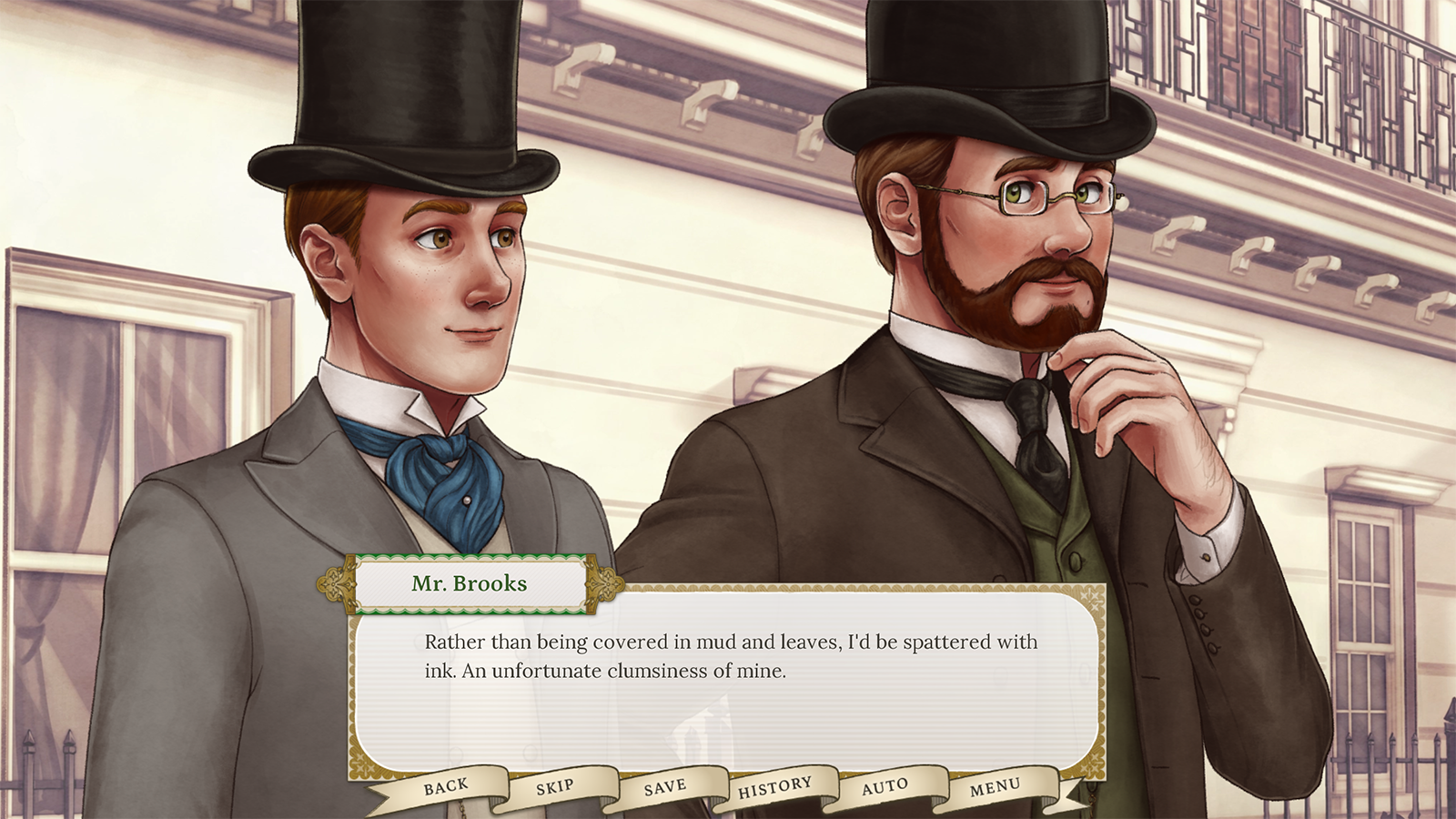
In the demo, it’s mentioned how the two, both together and as individuals, will depend on their choices. What sort of influence can players expect from their choices and how that will result in a particular ending?
The choices in Of Sense and Soul are designed to feel very realistic, in that most have the player character adjust their approach to communicating with other characters—or how they reflect to themself. An answer given at the start of a chapter may influence conversations they have during the rest of the chapter or beyond, creating variances in the player character's relationship and personal development. There's no clear "right answer" for many choices, because we wanted to reflect the nuances and complexity of real communication.
As such, there's no clear "branching" of the plot, but the minute decisions players make—such as the opinions they express, the tone their letters are composed in, the order in which journal paragraphs are ordered, or the actions they do or don't take in conversation—slowly work towards crafting an ending. It is possible, as a result, to make the wrong choices at times and still achieve the most satisfying ending.
No matter what, romance will happen, and so will the events the main characters need to traverse for their own character development. The potential of them, however, is up to the player to uncover.
Our hope is that this will encourage players to think about their decisions beyond the choice itself to the bigger implications they may have on the main characters as a whole.
As noted on the game’s itch page, despite the game being set in 1875, Of Sense and Soul is a positive, uplifting queer story and will not display prejudices or discrimination of marginalized people from that time period. I think this was a fantastic decision! But for those who are curious, can you talk to us a bit about this decision and why it was important to focus on crafting a story where queer individuals are met with open arms?
This decision is something I feel very passionately about, so forgive me for getting on my soapbox: There is often a modern bias that the past was a hostile environment for everyone who diverged from the status quo, and this is a perception that is often applied to the Victorians.
That isn't to say there haven't been real prejudices, hate crimes, or acts of discrimination in the past—far from it.
But more often than not, those prejudices are conflated with entire time spans, narrowing the modern consensus on the opinions of people in the past to only the most documented, uncensored, and circulated ones.
If someone in the distant future looked back on the 21st century and assumed everyone must have loved Star Wars just because a lot of documentation is available for it, that certainly wouldn't be reflective of the diversity of tastes—or people—that exists in this time.
Queer people have always existed, and have even thrived in history, even in places and time periods we would associate with prejudice against them. The Victorian Era, especially, was queerer than one might think.
As such, it didn't make sense to (nor did we want to) give homophobia or other xenophobic views a foot to stand on. Queer people existed in history and went through their day-to-day the way we do today: affected by their circumstances, locales, and the voices surrounding them, but not devoid of happiness or contentment just because discrimination exists against them.
The main characters, Hugo and Seamus, don't necessarily "come out of the closet," but only in the sense of not growing or defining their identities through putting a name to their attractions. When their relationship fruitions, the focus is on the two of them—not what others might think or say.
Of Sense and Soul is a story meant to uplift and lend comfort to those who experience it, no matter their personal stories. Any queer panic in the plot is just feelings being dumb—as feelings always have been!
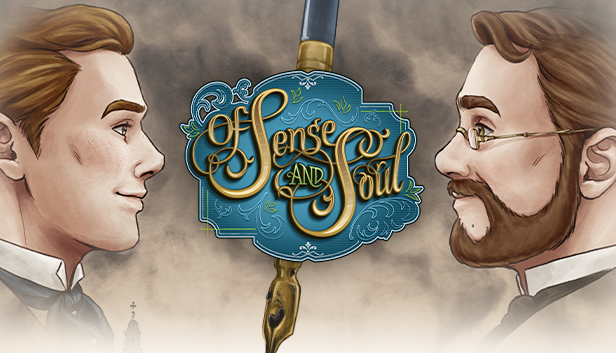
Can you tell our readers about what you’re working on and what they can expect to see from Of Sense and Soul in the near future?
Lots of exciting things are happening with Of Sense and Soul this year! We're in the process of adding partial voice acting to our Extended Demo, which you can download on itch.io or Steam now!
We also have plans brewing for a Kickstarter crowdfunding campaign towards May, to fund the production of the rest of OSAS. Of Sense and Soul is now becoming the story I only wished it could be all those years ago, and I couldn't be prouder of it, nor more excited for what is to come! It'll be a lot of work, but so, so worth it.
(If you've made it all the way to the end of this interview, thank you! I hope you found it interesting, and you can always holler at me on my socials.)
In addition to following Ingrid on her socials, you can follow Forsythia Productions and Of Sense and Soul on Twitter respectively to stay up to date on the game. If you are not on Twitter, you can follow Of Sense and Soul on Tumblr as well.